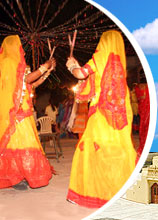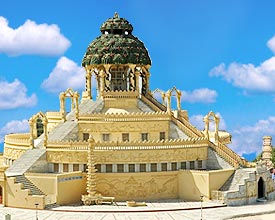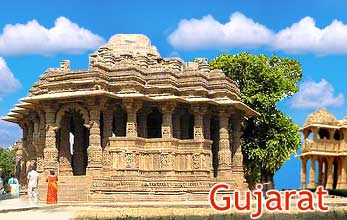 Bhuj
is situated in the Kutch district of Gujarat. It is the administrative
city of Kutch and therefore occupies an important place. If you are
traveling to Bhuj by road then it is around 396 km from Ahmedabad. Bhuj
is an interesting place due to the fact that it was once the capital of
the Princely state of Kutch. This makes Bhuj one of the popular places
in India, from travel and tourism point of view. It is dotted by a
number of affluent princely buildings of the yore which are truly a
feast for the eyes.
Bhuj
is situated in the Kutch district of Gujarat. It is the administrative
city of Kutch and therefore occupies an important place. If you are
traveling to Bhuj by road then it is around 396 km from Ahmedabad. Bhuj
is an interesting place due to the fact that it was once the capital of
the Princely state of Kutch. This makes Bhuj one of the popular places
in India, from travel and tourism point of view. It is dotted by a
number of affluent princely buildings of the yore which are truly a
feast for the eyes. This historic city is located between Bhujiyo Dungar Hill and Hamirsar Lake. The city has derived its name from the hill Bhujiyo Dungar only. The Rajput rulers of Kutch were supposed to have come to Bhuj from Sind or Northern India. The credit of establishing the city goes to Rao Khengarji I. He chose the strategic location at the base of the hill Bhujiyo Dungar and named the city as Bhuj in 1548 AD. The city served as the capital of the princely state till 1947 AD. The rulers of Bhuj enjoyed great support from the Mughal rulers also.
But after the decline of the Mughals, the rulers felt the need of security. As a result, the city of Bhuj was fortified. In 1819, the British overtook the fort. After that, Rao Pragmalji, another ruler, constructed three royal palaces in the city, Prag Mahal and Ranjit Vilas Palace at Bhuj and Vijay Vilas Palace at Mandvi. Another fascinating structure here is the Aaina Mahal. It was built by Rao Lakhpatji) in 1750 AD. He was a great patron of art and literature.
Tourist Attractions
Aaina Mahal
Aaina Mahal is one of the most exquisite monuments in Bhuj, located in the fort complex along with the Parag Mahal. The Palace is a sheer work of art and a must watch for all. The architecture of the Mahal is greatly influenced by the European style. Aaina Mahal was converted from a dream to reality by the master architect Ramsinh Malam. He undertook training in Holland to make Aaina Mahal an architectural marvel it is today. The palace is a two storied building with Darbar Hall, hall of mirrors, and suites for royal family. It stands adorned with mirror work, tile work and fountains.
Prag Mahal
Prag Mahal was designed by the famous architect Colonel Henry Saint Wilkins. It took 10 years to build the monument, at an astounding cost of rupees 20 lakh. The palace serves as a fine example of Italian Gothic style, combined with some European style elements.
The Kutch Museum
The Kutch Museum was earlier known as Fergusson Museum. It was built by Maharao Khengarji III in 1877 AD. The museum is constructed in Italian style and located on the banks of the Hamirsar Lake. It is one of the famous museums in the entire state and has a rich collection of Kshatrapa inscriptions, various archeological objects, fine collection of arms and specimens of various crafts of the Kutch region.
Other Places of Interest
Other places of interest at Bhuj are Cenotaphs of Kutch rulers, Snake Temple at Bhujiyo Hill Fort, Swami Narayan Temple, Vegetable Market, Hatkeshwar Temple and Alfred High School.
How to Reach Bhuj
By Air: Bhuj is connected by air to the major cities of India.
By Train: The railway station of Bhuj falls on the Gandhidham-Bhuj railway line.
By Road: State buses are easily available from Ahmedabad.









